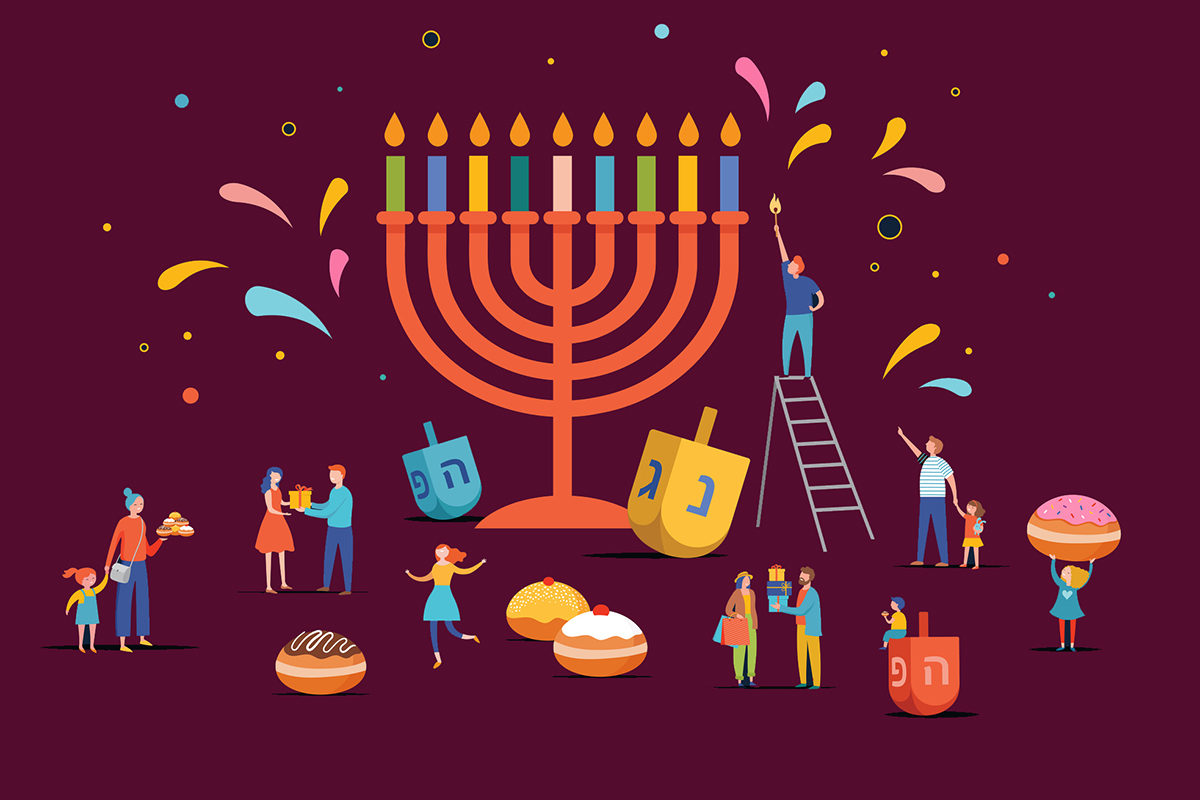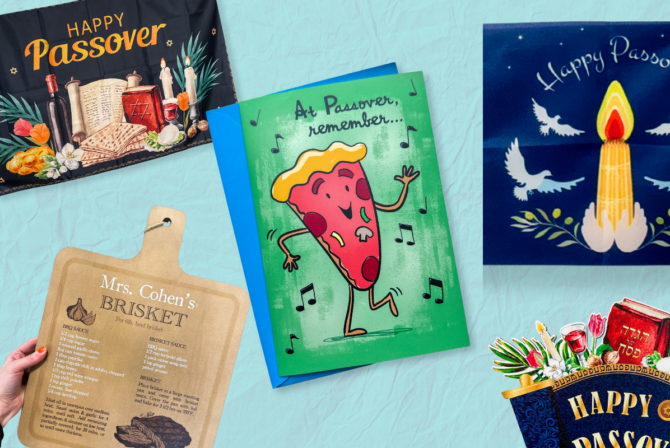For Jewish children, the excitement of Hanukkah is often connected to the promise of receiving gifts — usually one for each of the eight nights. For parents, however, the gift-buying and gift-giving can start to feel like a long-running episode of the Home Shopping Network, leading some of us to wonder: What messages are we imparting to our children during this time of year?
While our daughters were growing up, my husband and I paused to consider the values we wished to encourage during Hanukkah. Agreeing on “quality family time” as a main goal, we tried a new approach and categorized each of the eight nights — one night was game night, in which a board or card game would be gifted and then played together. Another was book night, then puzzle night, and so on. This provided added meaning and welcomed structure for us gift-buyers and helped set our kids’ expectations.
My kids are grown now, but I’ve recently had Hanukkah on the brain again, and not just because it’s merely a few weeks away. As I was writing my newest picture book, Goodnight Bubbala, I visited with Pamela B. Schwartz, the director of the Penn Family Early Childhood Center at Park Avenue Synagogue. While discussing the themes of my book and Jewish American culture today, Pamela shared the list of eight Jewish values central to the school’s Jewish Life Curriculum, such as hesed (showing kindness and helping others) and hachnasat orhim (welcoming guests).
These struck me as exceptional guiding principles for children — and adults! — of any age. But outside of the school setting, I wondered: How could these eight core values be reinforced? Once again, I thought: Hanukkah! Eight core Jewish values on each of the eight nights of Hanukkah could be taught through games and activities while enjoying quality time together. With families, grandparents and friends gathering for the Festival of Lights, it seems like a wonderful time to impart these everlasting gifts.
Framing your Festival of Lights around these values can bring special, long-lasting meaning to your Hanukkah traditions. At the same time, they can inspire your child to be a kind and thoughtful person — in other words, a mensch. What better gift is there than that?
Read on to learn more about these values, and how you can incorporate them into each night of Hanukkah.
1. Hachnasat Orhim: Welcoming guests
DISCUSS: Offering a guest food, company, and welcoming words teaches kindness and helps creates a community that cares for one another.
DO: Before friends or the whole mishpacha arrive for a Hanukkah gathering, role-play this game: Pretend you are the guest and your child is the host. “What will you do when guests arrive at the front door?” Decide on a warm greeting, such as “Happy Hanukkah!” Act out other ways to be hospitable, such as taking a coat, carrying a bag, or offering food and drink.
2. Haver Tov: Being a good friend
DISCUSS: Jewish tradition teaches the value of friendship. As it says in Ecclesiastes: “Two people are better off than one, for they can help each other succeed. If one person falls, the other can reach out and help. But someone who falls alone is in real trouble.”
DO: In advance of gathering with another family, discuss what it means to be a “good friend.” Which toy or book might your child share? Make a plan for your child to work together with a friend, such as helping to prepare food or setting the table.
3. Bikkur Holim: Visiting those who are sick
DISCUSS: Visiting a person who is sick or in pain teaches compassion and appreciation of one’s own health. Recall when your child may have been ill and how the care of others helped them feel better. “Is there someone we know who might be sick, or old, or lonely? What might make that person feel better?”
DO: On one night of Hanukkah, make or plan a visit to a person who is not well. Bringing news and conversation will lift that person’s spirit. If an illness is contagious, prohibiting a visit, you and your child can cook and deliver a meal, call to wish that someone a “Happy Hanukkah!” or make and send a get well card.
4. Bal Tashchit: Not wasting
DISCUSS: The Jewish concept of bal tashchit means to not destroy, or to not be wasteful of our natural resources. Sometimes we waste water, energy, paper, food, or toys. Discuss the three Rs with your kids: “How can we reduce, reuse, and recycle during our Hanukkah celebration — and beyond?”
DO: Make little signs to remember to turn off water and lights. Create a paper recycling box. Do not use food for art projects. Also, remember there’s a fourth R, too: What if your child receives a gift they don’t like or won’t really use? Discuss “re-gifting” – giving the gift to another child who might enjoy it.
5. Hakarat HaTov: Expressing thanks
DISCUSS: Hakarat haTov encourages gratitude by reminding us to “recognize the good” all around us. Acknowledging what we have to be thankful for, especially beyond material possessions, can help a child feel grounded, grateful and happy.
DO: Make a game of the Jewish tradition of finding 100 blessings in each day. See how many “blessings” you and your child can find — they can be as simple as the sun, eyesight, or a warm bowl of soup. (Also, you can read my book, Goodnight Bubbala, and find the many expressions of gratitude in taking the time to say goodnight to one’s belongings and loved ones!)
6. Hesed: Showing kindness
DISCUSS: There are over 190 references to hesed in the Torah. Practicing loving-kindness is a primary ethical value of Judaism, which demands action. It encourages our children to give of themselves with love and compassion and to become thoughtful, giving members of their communities. Discuss with your kids the things we can do to be kind to someone else.
DO: On a night of Hanukkah, commit to good deeds for a friend, family member, or neighbor, such as helping an older person with a chore or walking a neighbor’s dog. For additional ideas and inspiration, check out the organization Areyvut which offers Daily Acts of Kindness emails that remind us that “one small action can help so many.”
7. Tzedakah: To give charitably
DISCUSS: As an extension of the concept of sharing — a value already familiar to most kids — tzedakah means that resources such as food, clothing, and shelter are shared with others who may be in need. It often implies gifts of money, but giving of one’s time, expertise, or even a friendly smile are all forms of tzedakah. Modeling charitable giving can help kids feel that, even in small ways, they can be helpful to others.
DO: Ask: What can our family give for tzedakah? When preparing for Hanukkah and visiting the grocery store, you can purchase extra boxes or cans of food and deliver them to a food pantry. You can volunteer together at a home for the elderly. For an older child, you can give a gift card from an organization such as GlobalGiving or Changing the Present, which will allow your child to learn about and connect to a cause that they care about.
8. Tikkun Olam: Repairing our world
DISCUSS: In the Jewish tradition of “healing the world,” what can your child and family do to help fix what is wrong with the world? Discuss issues related to the environment and humankind such as homelessness and hunger. According to Feeding America, 1 in 5 children in the USA lack dependable access to food. Give examples of actions you have taken in your own life to lead or affect change.
DO: Read books to inspire, such as Swimmy, by Leo Lionni, which teaches the power of children joining together against injustice. And “Amrita’s Tree” in The Barefoot Book of Earth Tales by Dawn Casey and Anne Wilson, about how one girl and her mother protect the trees integral to their village’s way of life.
Then, decide on actions. Lead a coat drive. Participate in a park cleanup. Help start a community garden. Activist activities like these will empower your child and family to help repair the world.
Image via Getty Images / ma_rish








